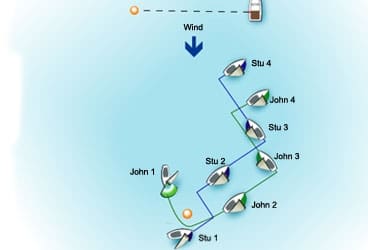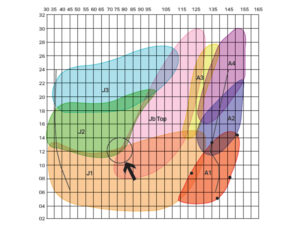
Stu leads John around the mark and promptly positions himself upwind in order to clear a lane to the right. When John tacks to the middle, Stu applies a tight cover to redirect him. Once he’s done this, he keeps a loose cover to comfortably stay bet
When discussing strategies, it’s easy to treat the first beat and the last beat as one in the same, but they’re not. The first beat is a time to move away from the fleet into a leading position. The last beat is more than simply covering the boat behind; it’s about staying ahead in the race, and more importantly, staying ahead in the standings.As you approach the leeward mark for the last beat, make a big-picture assessment by asking a few questions: What’s the wind doing? Is the current favorable or adverse? Which side of beat paid in earlier races? If your game plan worked on the first beat, and conditions are the same, go towards that side harder if you’re sailing a short course. If your game plan didn’t work on the first beat, or the conditions have changed, devise a new plan. Once you assess these factors, evaluate where your competition is and what you need to do to either try and pass or stay ahead.Your other objective is to be in phase, sailing towards the next shift as quickly as possible after rounding. If you’re sailing towards the leeward mark without needing to change course and you’re easing sails or poling back, you’re lifted, so you should consider remaining on that lifted tack after rounding. If you’re easing the pole forward or trimming the sails harder as you reach the bottom of the run, you’re headed. In this case, consider tacking into a clean lane on the lifted tack as you exit the mark.No matter what your intentions are after the rounding, always approach the leeward mark wide and finish tight, maintaining your speed through the turn. Passing the leeward mark tight allows you to briefly luff during the rounding, which puts you above the centerline of boats behind and ahead and gives you a lane out of the mark. This luff also prevents another boat from hipping up on your weather quarter, which could prevent you from tacking when you want to. Also, you never want to round a leeward mark with your bow trapped to leeward of the boat ahead; you’re starting the beat in a dirty lane with no option to tack.If you round the leeward mark with a lead, and the objective is to cover a boat that’s behind you, take one short hitch toward the fleet coming downwind. Once the distance is halved, tack back and you’ll be directly to windward of the boat you need cover as they exit the mark. You can control them from here.When to herd the competitionIf you round near the top of the fleet, it’s logical to wonder whether you need to cover the boats behind. The answer depends on where you are in the series. If you are sailing an early race in a regatta, or if your competition is not directly behind you in a later race, consider “herding the fleet.” When herding, the strategy is to stay between the fleet and the finish line, using your speed while directing the competition toward the next shift or favored side of the course. By doing so, you minimize the amount of leverage you give to other boats, and limit their ability to pass you. In order to make this strategy work, however, you need to set up in a controlling position by tacking to abeam and to windward so your wind shadow is not affecting the boats to leeward on the same tack. This allows your competition to sail toward the favored side with a clean lane where you can keep tabs on them. If they tack away you can do the same and then hit them hard with a tight cover to redirect them back toward the side you wish to go. (Or, if you feel strongly that they’re going the wrong way, you can just let them go.) When herding, it’s useful to push the fleet to the layline, where they’ll be unable to pass.When to cover a competitorYou should only cover a particular boat when you need to beat them in a particular race. This may occur in early races within a regatta as you make the final approach to the finish line, or when you wish to maintain your position over a short distance. It’s often nearly impossible to match a boat tack for tack and stay on their wind. A tacking duel is usually not necessary because your objective is simply to stay ahead of an opponent and not hurt them. Furthermore, with a tacking duel, all you do is lose ground to the rest of the fleet. Most commonly, though, a covering strategy is a last-race tactic where you need to beat a particular boat for an overall finishing position in the regatta.Covering is a difficult skill to execute well, and you should know when to use a tight cover or loose cover. A tight cover is an aggressive tactic where you position your boat to windward so your wind shadow directly affects the boat you wish to cover. The idea is to slow them with your dirty air. If your masthead fly is pointed directly at the boat you’re covering, you’re affecting its wind. A wind shadow is more damaging in lighter conditions than windy conditions, projecting disturbed air as far as ten times the height of the mast to leeward. A high pointing boat will cast a wind shadow further aft than a boat that points lower.The strategy of a tight cover is to control an opponent with your wind shadow in order to keep them behind. The boat being covered must make a choice to either continue in this dirty lane or tack away. This tactic will either slow them down or force them to go the wrong way. The danger of a tight cover is you’re letting another boat dictate how you sail a race if you match them tack for tack. So use a tight cover for only short periods of time during a race where you’re forcing a boat to make undesirable choices, such as sailing in a dirty-air lane, forcing them to go the wrong way, or when you absolutely have to stay ahead of a boat.It’s also important to remember that if you cross a boat by less than one boatlength on opposite tacks, it’s hard to tack and plant a perfect cover on that boat. In a tight cover, you need to balance your distance to windward and the effect of your wind shadow in controlling the boat behind. Likewise, if you cross ahead of a boat by more than 10 boatlengths, your wind shadow will have no effect on its air, and all you can do is loose cover.A loose cover is a good way to stay in touch with a boat that you want to continue sailing in the direction you’re going. Similar to herding, you basically stay between the finish line and the opponent while you give them a clean lane to sail. There are some finer points to remember. In a loose cover in an oscillating breeze, you should consider tacking ahead and to leeward, always leading the covered boat into the next shift. Then, tack before they do in the new shift for a gain. In a persistent shift, or when a boat is sailing toward a layline, cover from weather, staying between them and the finish line. If you want them to continue sailing in a certain direction, give them a clean lane, and only use your dirty air to make them tack if needed later.In a loose cover, you can allow a boat to sail the wrong way, but once you’re on opposite tacks, quickly consolidate anytime they start to sail toward the favored side. With a loose cover, you’ll find that you will use your speed, rather than the position of your wind shadow to stay ahead of a competitor. You can release the other boat from your cover if you’re already laying the mark, sailing a big lift, or you’re absolutely sure they are making a mistake and you are going the right way. If you have to beat a particular boat, you find that your cover strategy is a combination of tight- and loose-cover tactics-hard cover when sailing the correct way and loose cover when going the wrong way.If you lose your cover, do not sail off in desperation; by sailing away, you’re less likely to pass the opponent you just lost. Also, keep this in mind if you find yourself behind a competitor you need to beat in the series. The easiest way to lose to them in the regatta is to take a flyer in the hope of passing them. This approach is sure to open the point spread between the two of you. The disciplined approach to staying ahead in the series is to sail the race in order to minimize the point spread between and have the confidence that you’ll either pass them in that race, or make up and put points on them in the next. Sail smarter, faster, and grind them down by executing the correct moves. This gives you a fighting chance to pass. When to go on the offensiveWhen you’re behind, sail in an offense mode. There may be few clear lanes, but you must find the best lane toward either the next shift or the favored side. Don’t sail the wrong tack on the last beat for a long period of time looking for a clean lane; settle on one that keeps you in the game, sailing towards the next shift. Work the middle in shifty conditions because the longer you can stay away from the laylines, the longer you keep your options open as you approach the finish. If sailing in a persistent shift, or the last shift of the beat, sail fast towards the shift in order to gain leverage on the boats around you. Look to pass groups of boats early in the beat and then pick off individual boats later in the leg as you approach the finish.When to go on the defensiveWhen you find yourself sailing in a defensive mode on the last beat, you are sailing to maintain your place and add as few points as possible to your score. Avoid tight covers and tacking duals with a single boat because they will only drag you back into the fleet. You may stay ahead of the boat you need to cover, but you may lose points to the fleet. This might be OK in the last race of the regatta if you have a cushion, but not in the first race. Early in a regatta, the goal is to minimize your points and keep your score low. That’s why it’s important to understand the differences between covering a boat and herding the fleet. Covering keeps you ahead of one boat, herding keeps you ahead of the fleet. In either case, you still need to sail the shifts better than other boats to stay ahead, so keep track of the wind. And one final point: let the gambler go. The last-beat flyer only works once in a while, and it’s only 1 point.Scott Ikle, head coach of Hobart & William Smith Colleges sailing team since 1993, led his squad to an impressive double in 2005, winning both the ICSA/Layline North American Team Race and ICSA/Gill North American Coed Dinghy championships. http://www.hws.edu/athletics/sailing









